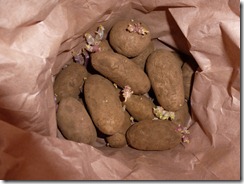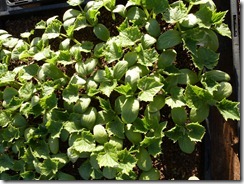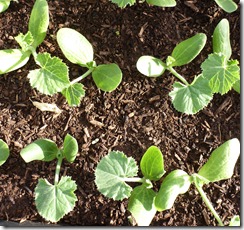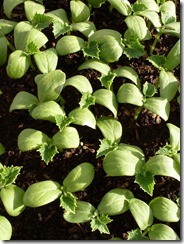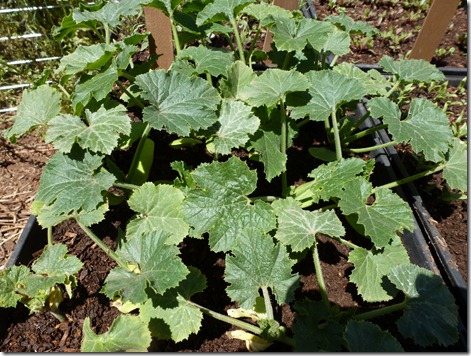
 Thirty-six days after planting zucchini seeds into potting mix the seedlings are ready to be transplanted into the garden beds. Leaves look like miniatures of those that will adorn the adult plants and they are starting to crowd each other in the seed tray.
Thirty-six days after planting zucchini seeds into potting mix the seedlings are ready to be transplanted into the garden beds. Leaves look like miniatures of those that will adorn the adult plants and they are starting to crowd each other in the seed tray.
Of all the seeds planted five weeks ago the zucchini seeds developed the fastest, perhaps helped along by the large store of energy and nutrient supplied by the parent plant when the seeds were formed a year or two ago.
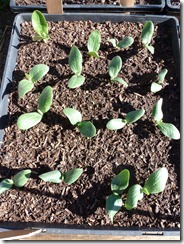 All seedling have to survive ‘transplant shock’ - disturbance to their root systems when the seedling is planted out into full sun conditions and into soil at a different temperature and moisture level to that in which it has grown up. This often leads to immediate wilting, and so one must ensure that the seedling has had plenty of water right up until plant-out to fully hydrate it. Seedlings should also have been ‘hardened up’ by being out in full sun all day long rather than under the shade cloth covering many nurseries. If possible, I plant out on the evening of a cool day. This gives the seedlings time to settle in before coming under high atmospheric demand under the midday sun.
All seedling have to survive ‘transplant shock’ - disturbance to their root systems when the seedling is planted out into full sun conditions and into soil at a different temperature and moisture level to that in which it has grown up. This often leads to immediate wilting, and so one must ensure that the seedling has had plenty of water right up until plant-out to fully hydrate it. Seedlings should also have been ‘hardened up’ by being out in full sun all day long rather than under the shade cloth covering many nurseries. If possible, I plant out on the evening of a cool day. This gives the seedlings time to settle in before coming under high atmospheric demand under the midday sun.
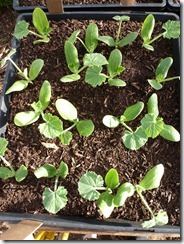 There’s one other thing that I have to look out for; insect attack. Earwigs and slater beetles in the mulch come out to feed at night; they are especially thrilled to find new and vulnerable seedlings to feast upon. I guard against this by putting the hens into empty seed beds for a week or two prior to planting; their scratching and hunting completely wrecks these pest populations.
There’s one other thing that I have to look out for; insect attack. Earwigs and slater beetles in the mulch come out to feed at night; they are especially thrilled to find new and vulnerable seedlings to feast upon. I guard against this by putting the hens into empty seed beds for a week or two prior to planting; their scratching and hunting completely wrecks these pest populations.
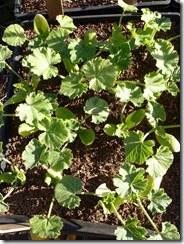 I do have one more trick up my sleeve to combat insect pests; short lengths of PVC 90-mm pipe that I saw off long lengths of storm water pipe to act as seed guards. Not only do they keep pests out, but they also stop mulch blowing over the seedling and weakening it by blocking access to sunshine and photosynthesis. These guards are pushed about 10mm into the soil (without touching the top roots) and pinned down with galvanised hooks normally used to hold the irrigation piping in place.
I do have one more trick up my sleeve to combat insect pests; short lengths of PVC 90-mm pipe that I saw off long lengths of storm water pipe to act as seed guards. Not only do they keep pests out, but they also stop mulch blowing over the seedling and weakening it by blocking access to sunshine and photosynthesis. These guards are pushed about 10mm into the soil (without touching the top roots) and pinned down with galvanised hooks normally used to hold the irrigation piping in place.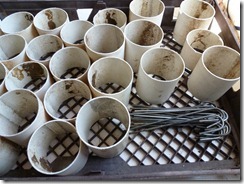
Much of the soil preparation has been done over winter by the hens; they have kept weeds and insect populations down and broken up the surface mulch. That’s mulch that I’d laid over the beds in late autumn to capture the winter rains in the soil profile. Now it provides the cover that will protect the seedlings from too-rapid fluctuations in soil moisture while they strive to get their root systems deeper into safer and moister soil. Because this is now ‘old mulch’ it doesn’t steal nitrogen from the seedlings in breaking down; it’s already done so.
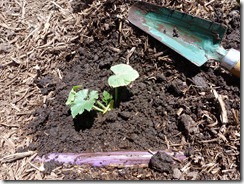 These garden beds are all fenced, so now the hens are locked out and the pre-established drip lines turned on to show me where the wettest spots are along its length; these mark the best locations for planting the seedlings, as I know they will have first access to irrigation water even when that water becomes scarce or is being dried out rapidly by the giant leaves of the mature zucchini plants.
These garden beds are all fenced, so now the hens are locked out and the pre-established drip lines turned on to show me where the wettest spots are along its length; these mark the best locations for planting the seedlings, as I know they will have first access to irrigation water even when that water becomes scarce or is being dried out rapidly by the giant leaves of the mature zucchini plants.
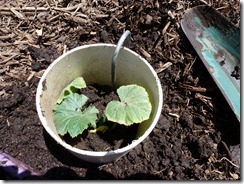 The seedlings are lifted out of the seed tray by hand so that the root mass between seedlings separates readily. As much of the original soil as possible is kept around the seedling’s roots. The seedling is laid into the crumbled bottom soil of a hole dug in the wet soil alongside the drip line. The soil is gently returned to surround and cover the roots and tamped down with slight pressure to ensure that the soil and roots are in good contact without too much air.
The seedlings are lifted out of the seed tray by hand so that the root mass between seedlings separates readily. As much of the original soil as possible is kept around the seedling’s roots. The seedling is laid into the crumbled bottom soil of a hole dug in the wet soil alongside the drip line. The soil is gently returned to surround and cover the roots and tamped down with slight pressure to ensure that the soil and roots are in good contact without too much air.  Finally the seedling guard is added and pinned down. Dry mulch is laid around the outside of the guard to prevent the soil water around the seedlings from being exposed to direct evaporation by the sun.
Finally the seedling guard is added and pinned down. Dry mulch is laid around the outside of the guard to prevent the soil water around the seedlings from being exposed to direct evaporation by the sun.
Sixteen zucchini plants are sown in under an hour; many of these will find their way into soups, vegetable side dishes, quiches, the freezer or used as food for those hens who worked so hard to prepare the ground for their arrival.
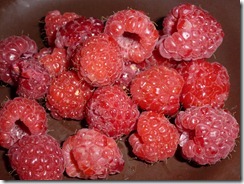 Most commercial berries are grown in cool-climate areas such as the Adelaide Hills. Much head-shaking was the general response to my queries about why I too couldn’t grow raspberries down in the warmer areas of the Adelaide Plains. I guess I was just too stupid to listen to the naysayers, so went ahead and planted anyway, but in the coolest spot in the garden.
Most commercial berries are grown in cool-climate areas such as the Adelaide Hills. Much head-shaking was the general response to my queries about why I too couldn’t grow raspberries down in the warmer areas of the Adelaide Plains. I guess I was just too stupid to listen to the naysayers, so went ahead and planted anyway, but in the coolest spot in the garden.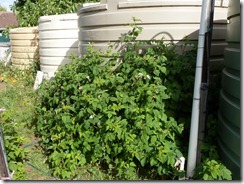 And where is this raspberry-haven in the garden? On the cooler south-side of the massive rainwater tanks that sit stolidly at a pleasant cool temperature through the heat of summer. Each tank holds just over three tonnes of winter rainfall, so comes into spring at a pretty cool temperature anyway, warming only very slowly as the season progresses.
And where is this raspberry-haven in the garden? On the cooler south-side of the massive rainwater tanks that sit stolidly at a pleasant cool temperature through the heat of summer. Each tank holds just over three tonnes of winter rainfall, so comes into spring at a pretty cool temperature anyway, warming only very slowly as the season progresses.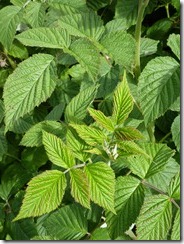 This variety fruits twice a year, in spring and autumn, before being cut back hard as winter approaches. I’ve set up a trellis that follows around the wall of the tank; this carries the weight of these thornless canes.
This variety fruits twice a year, in spring and autumn, before being cut back hard as winter approaches. I’ve set up a trellis that follows around the wall of the tank; this carries the weight of these thornless canes.









